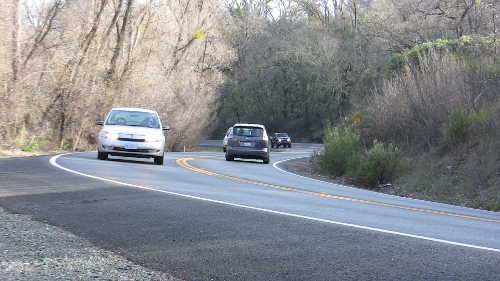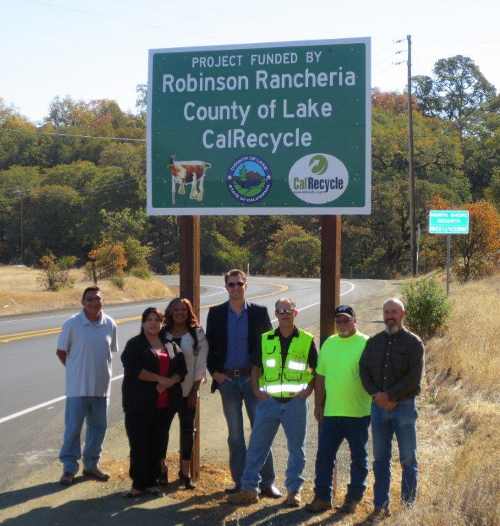
LAKE COUNTY, Calif. – Lake County has encountered a lot of bumps in its efforts to improve the surfaces of its roads. But it may be turning the corner to a brighter future of smooth roads through a system of collaboration.
Collaboration between property owners and county government, and collaboration between local pols and the band of Pomo Indians residing in the area suggest that a new paradigm for progress is in the making.
The homeowners of Clear Lake Riviera struck an agreement with the Lake County Board of Supervisors in which they are taxing themselves about $125 a year for the next seven years to pay for resurfacing a particularly choppy road conditions in the vicinity of Tenaya Way and Chippewa Trail.
“We were lucky that the board listened,” said Tom Nixon, a Clear Lake Riviera resident and principal liaison with the county. “We told them we want to help you help us fix the roads. I told (the Board of Supervisors) that we could be part of the solution. We're willing to pony up.”
Under terms worked out with the county, a 58-42 percent agreement on costs for the project was established between the subdivision homeowners and the county.
But, before securing this agreement there was a labyrinth of what Nixon calls “pothole politics.”
Opposition included multi-lot owners who would have to pay $166 for each lot, later reduced to $125.
“I own two lots,” said Nixon. “But I can afford to do it; we can all afford to do it. For $13 a month? We spend that in a week in a coffee shop.
“If you don't like what I got, what have you got? Put it on the table. Tell me how you're going to fix the problem,” he told dissidents.
No one did.
When the Clear Lake Riviera was originally developed in the 1970s, its homeowners association bore responsibility for maintaining the roads.
In time, the association voted to shed itself of that responsibility and turned it over to the county. But the county plainly didn't have the funds to cover road repair in the subdivision.
“There's not really enough money to come up and fix these roads,” said Nixon. “We don't get the money from gasoline taxes and stuff like that.”
Consequently, Nixon added, “Ever since we purchased our home here in the 1980s the roads have been going downhill.”
The areas most in need of repair were where large trucks coming into the subdivision torque their gears to go uphill. The erosion went on for years, until Bob Lang, a resident, took the matter in hand.
“Bob was getting tired and angry about the deteriorating roads in his neighborhood,” recalled Nixon. “One day he decided to put handwritten notes on his neighbors' doors, requesting they join him in a meeting in his driveway one morning. A handful of folks showed up, a (Fix Our Roads) committee was formed and a strategy was formed that involved street captains, a website, county liaison, mailers and door to door contacts.”
Lake County Supervisor Rob Brown, whose district District Five encompasses Clear Lake Riviera, attended the first meeting of the homeowners and shepherded it through the Board of Supervisors.
Brown's guidance led to a board vote to allow the residents of the projected repair area a chance to vote for or against the improvement as a simple majority. This followed an election in which a majority of residents voted to assess themselves for a complete full-depth repair of the roads.
The road repair agreement was by no means a county landmark.
“It's been done seven or eight times,” said Brown. “We did Buckingham, we did them in West Riviera Heights, Orchard Shores and Kelseyville. These things can be done anywhere with residents. We try to get (agreements) closer to 50-50.
“I started pushing (the Clear Lake Riviera homeowners' proposal) because I've become pretty attuned and knowledgeable on how to process work and what the costs are. So I've become successful advocating for them and I definitely am a proponent for them,” Brown added.
The partnership between the county and the tribes was launched by the Pomo Indians of Robinson Rancheria, who approached county director of public works Scott De Leon with an offer of funding.
“They came to us and said, 'We've got some funds and we'd like to partner with you on a project,'” said De Leon. “It was gaming litigation money – money they pay the state. There is a commission that reviews application money and we got a notice that the commission is accepting applications and nominations for projects.”
The county, said De Leon, has received tribal funding that has gone into impacts on roads in the Konocti Vista area “which we've used on a couple of projects.”
Robinson Rancheria, meanwhile, has used funding from the federal economic stimulus package signed into law on Feb. 17, 2009, for a project to improve the county-owned Nice-Lucerne Cutoff.
“We had a little bit of extra road money left over from a high-priority project funded at the Rancheria roads this past summer,” said Anthony Duncan, the GIS/GPS (map) specialist for the band of Pomo Indians at Robinson Rancheria.
“The project that we did was a 10th of a mile on the east side of Rodman Slough,” he said. “We are still in touch with county transit (regarding) other routes that are reconstructed or constructed specifically all around the rancheria,” Duncan added. “In actuality, we are trying to turn over some of the county routes that they are having trouble maintaining. If ownership cannot be turned over we still want to help in rehabbing or reconstructing these roads.”
Brown pointed out that gaming funds are not provided “for all the roads, just to the roads that are impacted by gambling,” in other words, roads that lead to a casino.
“But there are a couple of projects that they have done that contribute money to roads, as well as to the sheriff's department and the DA (district attorney) that is a huge benefit to us,” he said.
Both Brown and De Leon are certain the tribes' contribution will be a part of the aforementioned new paradigm for maintaining and upgrading the county's roads.
“We have been neighbors,” Duncan reasoned. “Not just locally, but on county and state routes. There will be tribal help for roads that go to the grocery stores, the hospitals, and the schools.
“Everybody is strapped for money so we're going to have to pull our resources together . . . and we're not the only ones doing it,” Duncan added. “I'm sure counties and tribes working together is done all across the country.”
“We're able to do a lot more work by partnering with the tribes,” said De Leon.
“I'm hopeful that the projects we just completed on the Nice-Lucerne Cutoff and on Soda Bay Road with two different tribes will show that we can work collaboratively to get things done,” he said.
“I don't think it's a secret that historically there has been a mistrust between tribes and government,” De Leon added. “It's a very deep-seated mistrust and I'd like to think that the projects that we're working on is a good start to working together.”
Email John Lindblom at


 How to resolve AdBlock issue?
How to resolve AdBlock issue? 



